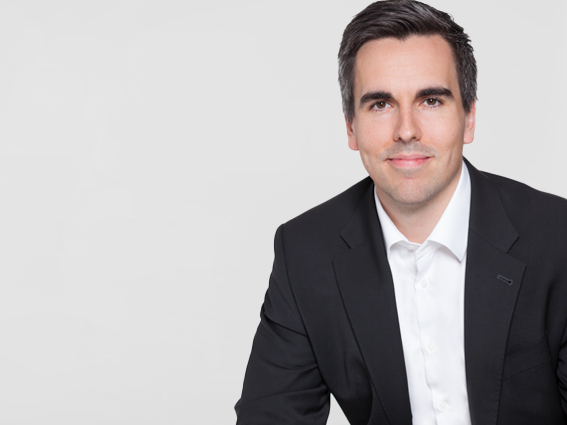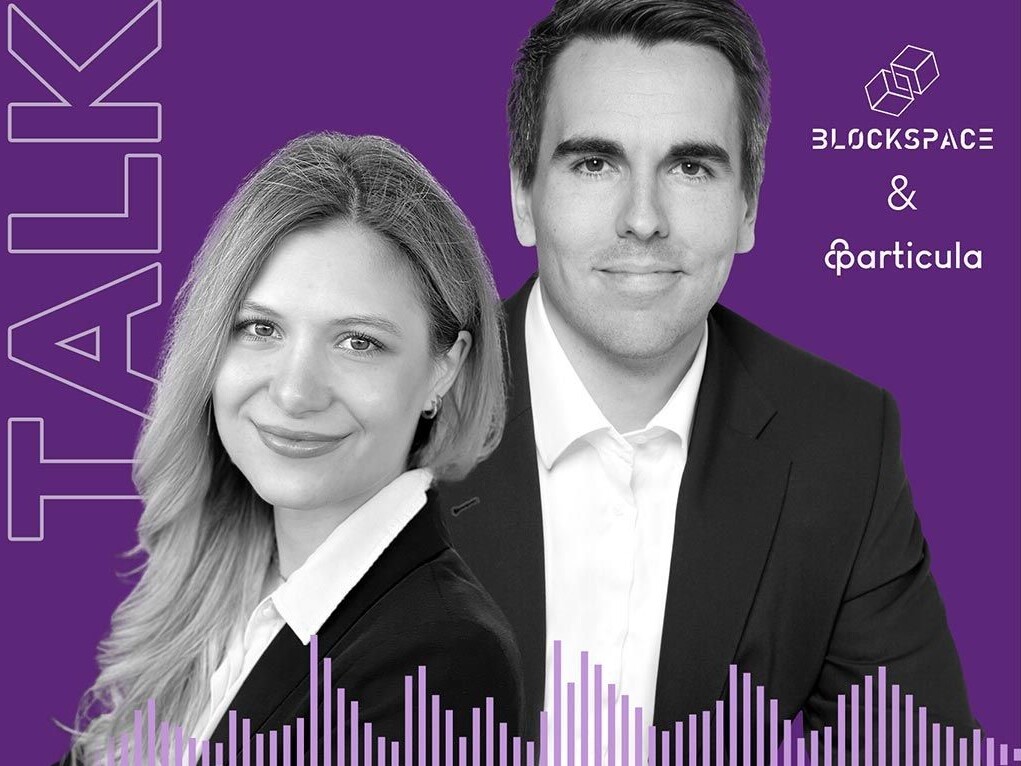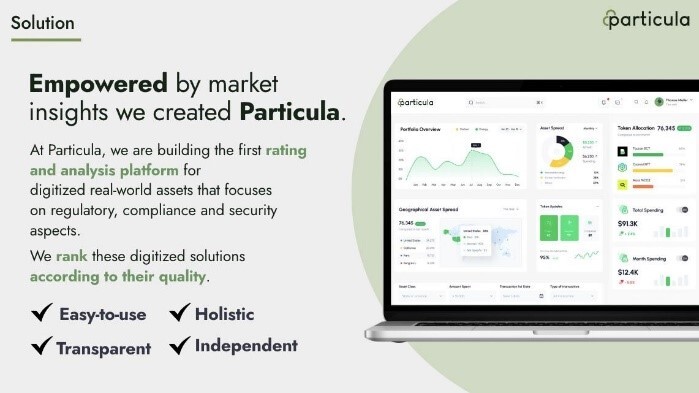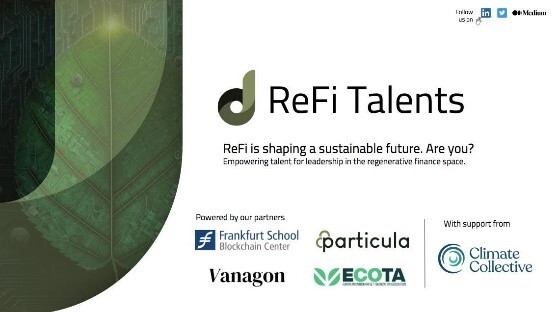
Regenerative Finance - High-quality data and blockchain ensure greater transparency

#ClimateFinance #RegenerativeFinance #ImpactInvesting #Blockchain #CarbonAssets #Web3 #DigitalAssets
Following Decentralized Finance (DeFi), Regenerative Finance (ReFi) is another emerging trend on the international financial markets. In this rapidly growing ecosystem, FinTechs are using blockchain to tokenize sustainable environmental goods and make them tradable. In our ReFi blog post, we also take a detailed look at the specific features and current developments in this still emerging segment.
Tokenization is creating new digital financial instruments for environmental assets in the ReFi sector, such as the tokenization of CO₂, which are characterized by transparency and high data quality and set new standards for impact investing. However, the data situation is still unclear. As a result, it is often difficult to understand how investments in digitalized sustainable assets actually impact the climate.
Particula: A comprehensive data and rating platform for tokenized real-world assets
The Munich-based FinTech Particula is building a holistic, automatically generated data and rating platform for tokenized real-world assets. As the “Moody's for tokenized assets”, the founders have set themselves the goal of increasing transparency in the sector and providing investors and companies with a sound basis for investment decisions. In an interview, Particula co-founder Nadine Wilke explained how they work and the special business idea behind their start-up:
Philipp Misura: With Particula, you are already firmly in the saddle of the ReFi movement. Where do you see your mission and how do you want to fulfill it?
Nadine Wilke: Our mission with Particula is to make the market for tokenized assets more understandable and accessible for professional investors. We are primarily concerned with harmonizing asset specifications and providing a reliable information platform that gives investors valuable insights for their due diligence, compliance and risk assessment processes.
In this context, the area of regenerative finance in particular offers us an excellent entry point, both from an issuer and client perspective, due to its dynamically growing adoption rate.
Blockchain as an infrastructure and the integration of other emerging technologies such as AI (“artificial intelligence”) or IoT (“Internet of Things”) can increase transparency, liquidity and traceability, particularly in voluntary CO₂ certificate trading. The increasing digitalization of trade is reducing information asymmetries and increasing efficiency.
As this has met with approval in the industry, a lively ecosystem of different providers has developed, which start at different points in the value chain of a certificate. On the customer side, this value chain usually begins with providers who support companies in determining their respective carbon footprint. On the issuer side, they develop the corresponding offsetting projects with project developers in Asia, South America or Africa. What follows is the auditing and verification of the project and the amount of CO₂ bound or absorbed, as well as the subsequent issue of a CO₂ certificate representing 1 tonne of CO₂.
The technical implementation of the digital representation on the blockchain is carried out by tokenization providers. At the same time, an increasing number of project developers are integrating specialized DMRV providers (“Digital Measurement, Reporting & Verification”), which open up new data sources through the use of satellite images or remote sensors.
In the best case scenario, this collected data is automated and transferred transparently and unalterably to a corresponding blockchain ecosystem in real time for project validation. This naturally represents a gain compared to the non-transparent and inefficient existing certificate trading.
We see further areas of application for the integration of blockchain in the area of sustainability in all types of impact certificates (biodiversity, water, plastics), in the area of renewable energies, in project financing for wind farms or solar plants, in the area of precious metals, rare earths or impact investments through structured products such as bonds or funds.
However, the above example quickly shows that technological integration increases the volume and complexity of data. At the same time, new implications arise with regard to the regulatory treatment, custody and trading of these new financial instruments. This also increases the need for specialized data providers.

In conversation with Nadine Wilke
Philipp Misura: You also refer to yourselves as “Moody's for digitized real-world assets”. What exactly do you mean by that and what does the product look like?
Nadine Wilke: The structure of our platform is equivalent to that of traditional rating and data providers such as Moody's, Sustainalytics or Bloomberg. This means that we have web3 content, but a web2 tech stack.
Our customers can use the platform to search for tokens, filter and compare them and retrieve the corresponding ratings. Our ratings evaluate tokenized assets based on their technical, economic, environmental and compliance aspects.
In addition to analyses for carbon tokens, we currently provide token data from 25 asset classes. We focus primarily on alternative investments in the sustainability interface, but will also evaluate all tokenized assets in the future. For example, shares in real estate. To do this, we aggregate data from freely available sources and also work closely with the relevant issuers to obtain data. Our business model is a classic subscription model.
Philipp Misura: You also refer to yourselves as “Moody's for digitized real-world assets”. What exactly do you mean by that and what does the product look like?
Nadine Wilke: The structure of our platform is equivalent to that of traditional rating and data providers such as Moody's, Sustainalytics or Bloomberg. This means that we have web3 content, but a web2 tech stack.
Our customers can use the platform to search for tokens, filter and compare them and retrieve the corresponding ratings. Our ratings evaluate tokenized assets based on their technical, economic, environmental and compliance aspects.
In addition to analyses for carbon tokens, we currently provide token data from 25 asset classes. We focus primarily on alternative investments at the interface of sustainability, but will also evaluate all tokenized assets in the future. For example, shares in real estate. To do this, we aggregate data from freely available sources and also work closely with the relevant issuers to obtain data.
Our business model is a classic subscription model. We also license our ratings for use on external marketplaces, stock exchanges or the issuers' distribution channels.
Philipp Misura: What is the main target group for your data platform? Who are your potential customers?
Nadine Wilke: Our main target group comes from the financial services sector. We focus in particular on crypto-asset providers and crypto-hedge funds that want to expand and diversify their business areas. We help them to identify new and high-quality tokens.
At the same time, we are also seeing steady interest from marketplaces and exchanges that want to use our ratings to strengthen the credibility of the investment vehicles they sell. We also see future potential with traditional asset managers. We are currently in dialog with various industry experts in order to better understand their specific information requirements.
Last but not least, companies that already use tokenized vehicles for offsetting are also showing a steady interest in our products. In our opinion, demand in this customer segment will steadily increase in the coming years, particularly due to the tightening of disclosure and reporting obligations.
Philipp Misura: In the context of greenwashing, reputation and data quality play a central role in the ESG sector. How do you obtain your data and how do you guarantee its quality?
Nadine Wilke: That is indeed a challenge. At the moment, we still aggregate some data manually and through bilateral communication with issuers. This requires numerous discussions and analyses. We also use data scrapers to access publicly accessible databases and obtain information directly from websites and blockchains, or more precisely, the corresponding block explorers.
Our goal is to fully automate all of these processes in the future. There are already some providers with robust databases, but the quality of the data varies greatly. In the case of nature-based solutions, such as forest protection or reforestation, data collection is particularly challenging.
Conversely, with technology-based solutions like biochar, the data foundation is robust thanks to solutions that directly read out CO2 storage and can be transferred to the blockchain in real time.
Traditional players like Earthood certify projects on-site based on existing quality standards and criteria. Verification bodies like Verra and Gold Standard not only monitor compliance with standards and criteria but also verify the existence and execution of a project. These controls reinforce the project’s credibility and transparency.
However, Verra has recently faced criticism for awarding excessive CO2 certificates for reforestation projects, resulting in overestimated project impacts. This underlines the existing inefficiencies in the traditional market and the necessity to integrate new technologies like blockchain, AI, and IoT to foster required transparency and trust.
Philipp Misura: Who do you perceive as competitors in the market for platform-based ratings and analyses? Other startups and fintechs, or established players like MSCI or Morningstar with Sustainalytics?
Nadine Wilke: In our dialogue with established rating providers, we’ve learned of their significant interest in our business model. Yet, the conventional industry lacks expertise in this realm. Contrary to their evaluations of companies based on creditworthiness or ESG criteria, we focus on tokens as comprehensive financial instruments representing rights to real assets. These two methodologies are not directly comparable.
Conversely, there are startups operating in similar fields, such as cryptocurrency valuation. The functioning of the crypto market undoubtedly requires multiple data platforms and rating providers. Therefore, we don’t perceive rising competition as a threat, but as an enhancement. It demands considerable efforts to aggregate data in this dynamic and burgeoning industry and develop a complex rating algorithm. The competitive advantage we’ve amassed here is substantial.

Philipp Misura: What resources are you currently in need of to continue your growth? Developers, investors, or influencers?
Nadine Wilke: We’re preparing to structure our next funding round in the third quarter of 2023. In this pursuit, we’re actively engaging with potential lead investors from the finance industry and are open to extending our network. Moreover, we’re currently spearheading an initiative called ReFi-Talents in collaboration with the Frankfurt School Blockchain Center. It’s an 18-week training program at the intersection of sustainability and Web3, for which we are eager to bring on additional sponsors and participants
To refine our products and gather essential feedback, we also provide prospective users with the opportunity to test our platform.
The essence of our conversation captures the pioneering spirit that’s prevalent in the ReFi sector. Both the infrastructure and financial instruments are still under development, while the landscape and quality of Impact Data for sustainable investments show significant diversity. The advent of new technologies, high-calibre datasets, precise and independent ratings, and lastly, an intensified regulatory environment, hold the promise of reinforcing trust in ReFi and innovative financial products. Furthermore, these developments can enhance the efficiency of directing investments towards significant climate projects.
The interview was conducted in German and subsequently translated.


